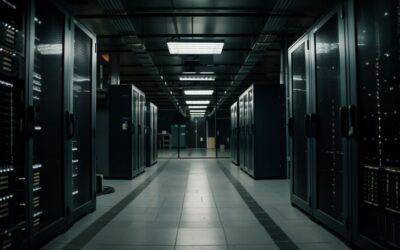Have you seen those dome-shaped cameras at shops or banks? They’re security cameras. Compact and unobtrusive, they mount on walls or ceilings. Their lenses hide behind dark-tinted covers. These cameras deter theft.. They withstand harsh environments. They even come equipped with infrared LEDs. Thinking about buying them for the physical security of your business? Here’s what you need to know.
What is a Dome Camera?
A dome camera is a surveillance device characterized by its circular, dome-like design. Easily affixed to walls or ceilings, its adaptability makes it perfect for both indoor and outdoor monitoring. Encased within its protective plastic dome is usually a wide-angle lens. The dome’s distinctive shape adds an element of unpredictability, making it hard for potential intruders to determine the direction it’s facing or exactly what it is seeing.
How Do Dome Cameras Function?
Dome cameras come equipped with infrared LED lights. This feature ensures clarity, even in minimal light. For example, the Reolink RLC-422 dome IP camera: with 24 infrared LEDs, it captures up to 100 ft in complete darkness.
Wired versions of these cameras use CAT5 or CAT6 cables. These cables provide power and transmit video signals. With this setup, you can view the footage from anywhere online. In contrast, wireless dome cameras send footage via WiFi. This method avoids cluttered wires and drilling. Note: They still need a power adapter.
The Benefits of Investing In Dome Cameras
1. Easy Installation
Dome security cameras offer a straightforward installation process. Simply position the bracket on the desired surface and secure the camera to the bracket. The camera is ready to go. Wired dome security cameras involve more setup due to the need to run and manage cables. However, their wireless counterparts connect through Wi-Fi, eliminating the need for video transmission cables.
Note: Once affixed to the ceiling, some outdoor dome security cameras may not be easily adjustable.
2. Discreet and Low Profile
Dome security cameras offer a covert security solution. Their design remains unobtrusive, meaning they don’t draw unnecessary attention. As a result, strangers won’t immediately identify camera locations. The dome casing further conceals the direction the lens points, preventing thieves from exploiting blind spots.
3. Wide Angle Coverage
These cameras excel in providing extensive coverage. With a field of vision reaching up to 80 degrees, they’re considered wide-angle. Some even expand to 180 degrees or more, with multi-sensor panoramic options. The dome shape and varifocal lenses offer both wide monitoring and adjustable focal lengths.
4. Night Vision Capabilities
Nighttime security remains crucial for many enterprises. Dome security cameras not only deliver high-definition recordings but also excel in low-light conditions. Their infrared capabilities ensure reliable surveillance even in pitch-black settings, with some models offering sharp imagery without any ambient light.
5. Weatherproof
Built to withstand harsh conditions, modern dome cameras function optimally in extreme temperatures, from scorching heat to freezing cold. Typically, outdoor variants come with ratings like IP65, IP66, and IP67, ensuring resistance to elements like rain and snow. Some even feature built-in temperature gauges and heaters for frigid environments.
6. Affordability and Durability
While quality should always be prioritized over cost, dome security cameras provide both. They’re a cost-effective solution with renowned durability, especially when sourced from trusted vendors. Regular maintenance and cleaning can further enhance their lifespan, offering long-term security without breaking the bank.
7. Vandal-Resistant
Dome security cameras are highly-resistant to tampering. They wear a tough exterior that prevents damage. Adversaries can’t easily meddle with or harm them due to their complete enclosure. They’d need special tools to even try. And their sleek form? It blends in, keeping security subtle yet strong.
What to Know Before Purchasing One
When searching for the perfect dome camera, consider the following factors:
- Resolution and quality: Start with the camera’s resolution and quality. A minimum of 1080p Full HD resolution ensures clarity in captured images. If you’re seeking even crisper footage, aim for cameras with 4K Ultra HD resolution.
- Night vision capability. Given that many incidents occur during low-light hours, night vision capability is essential. Cameras equipped with Infrared (IR) LEDs ensure clear night vision, but those with a longer IR range are more advantageous in dim settings.
- Lens type: A camera’s lens type and field of view greatly influence its coverage. Opt for varifocal lenses if you want the flexibility of adjusting both. For wider coverage, go for wide-angle lenses; for a more concentrated focus, zoom lenses are ideal.
- Wide Dynamic Range (WDR): In scenarios with stark lighting contrasts, like overpowering backlight or harsh glares, WDR maintains image clarity by ensuring balanced exposure.
- IP rating: Water-proof designs are non-negotiable, especially for outdoor surveillance. Check for an IP rating like IP66 or IP67 for dust and water resistance. For robustness against vandalism, cameras with an IK rating (e.g., IK10) stand out.
- PoE support: For installation ease, cameras with Power over Ethernet (PoE) support are your best bet. These units get powered and transmit data through a single Ethernet cable, cutting down the hassle of multiple cables.
- Mobile apps: Cameras that offer cloud based video surveillance via intuitive apps make things both flexible and convenient.
- Notifications: For real-time responses, motion detection and alerts are indispensable. Cameras with modifiable motion detection areas and sensitivity settings guarantee more accurate alerts.
- Software integrations: If you’ve invested in other security systems, it’s wise to consider dome cameras that allow integration with those systems. This integration promises a more cohesive security management experience.
Dome cameras play a key role in safeguarding assets from prying eyes. When you’re selecting a model, focus on critical features such as resolution and night vision. Proper integration capabilities further enhance security. With careful choice, you can ensure robust protection for your enterprise assets and data.



